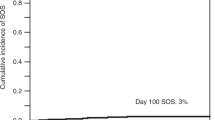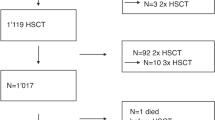Abstract
This retrospective cohort study of 462 consecutive adult allogeneic and autologous blood or marrow transplantation (BMT) patients compared the incidence of hepatic veno-occlusive disease (VOD) after BMT with three prophylactic regimens. Patients receiving heparin (Hep), heparin + prostaglandin E1 (Hep + PGE1) or low molecular weight heparin (LMWH) as a prophylactic VOD regimen were compared to a historical cohort receiving no VOD prophylaxis. Of 462 BMT patients, VOD was diagnosed in 22% (31 of 142) of the no prophylaxis group, 11% (11 of 104) of the Hep, 12% (13 of 110) in the Hep + PGE1 and 4% (four of 106) of the LMWH group (P = 0.0002). VOD was the primary cause of death in 20% (12 of 59). By multivariate logistic regression, independent risk factors for developing VOD were: no VOD prophylactic regimen, unrelated allogeneic BMT, Karnofsky performance score (KPS) <80 and aspartate aminotransferase (AST) ⩾50 U/l. There was no increase in the rate of death due to hemorrhagic events or VOD in any prophylaxis group compared to the control group. Prospective randomized trials of Hep vs LMWH vs placebo are warranted to assess the efficacy of heparin compounds in the prevention of VOD. Bone Marrow Transplantation (2001) 27, 627–633.
This is a preview of subscription content, access via your institution
Access options
Subscribe to this journal
Receive 12 print issues and online access
$259.00 per year
only $21.58 per issue
Buy this article
- Purchase on Springer Link
- Instant access to full article PDF
Prices may be subject to local taxes which are calculated during checkout
Similar content being viewed by others
References
McDonald GB, Sharma P, Matthews DE et al. Venoocclusive disease of the liver after marrow transplantation: diagnosis, incidence, and predisposing factors Hepatology 1984 4: 116–122
McDonald GB, Hinds MS, Fisher LD et al. Veno-occlusive disease of the liver and multiorgan failure after bone marrow transplantation: a cohort study of 355 patients Ann Intern Med 1993 118: 255–267
Jones RJ, Lee KSK, Beschorner WE et al. Veno-occlusive disease of the liver following bone marrow transplantation Transplantation 1987 44: 778–783
McDonald GB, Sharma P, Matthews DE et al. The clinical course of 53 patients with veno-occlusive disease of the liver after marrow transplantation Transplantation 1985 39: 603–608
Shulman HM, McDonald GB, Matthews D et al. An analysis of hepatic venocclusive disease and centrilobular hepatic degeneration following bone marrow transplantation Gastroenterology 1980 79: 1178–1191
Shulman HM, Fisher LB, Schoch HG et al. Veno-occlusive disease of the liver after marrow transplantation: histological correlates of clinical signs and symptoms Hepatology 1994 19: 1171–1181
Attal M, Huguet F, Rubie H et al. Prevention of hepatic veno-occlusive disease after bone marrow transplantation by continuous infusion of low-dose heparin: a prospective, randomized trial Blood 1992 79: 2834–2840
Rosenthal J, Sender L, Secola R et al. Phase II trial of heparin prophylaxis for veno-occlusive disease of the liver in children undergoing bone marrow transplantation Bone Marrow Transplant 1996 18: 185–191
Marsa-Vila L, Gorin NC, Laporte JP et al. Prophylactic heparin does not prevent liver veno-occlusive disease following autologous bone marrow transplantation Eur J Haematol 1991 47: 346–354
Carreras E, Bertz H, Arcese W et al. Incidence and outcome of hepatic veno-occlusive disease after blood or marrow transplantation: a prospective cohort study of the European Group for Blood and Marrow Transplantation Blood 1998 92: 2599–3604
Cahn JY, Flesch M, Brion A et al. Prevention of veno-occlusive disease of the liver after bone marrow transplantation: heparin or no heparin? Blood 1992 80: 2149–2150
Bearman SI, Hinds MS, Wolford JL . A pilot study of continuous infusion heparin for the prevention of hepatic veno-occlusive disease after bone marrow transplantation Bone Marrow Transplant 1990 5: 407–411
Gluckman E, Jolivet I, Scrobohaci ML et al. Use of prostaglandin E1 for prevention of liver veno-occlusive disease in leukaemic patients treated by allogeneic bone marrow transplantation Br J Haematol 1990 74: 277–281
Bearman SI, Shen DD, Hinds MS et al. A phase I/II study of prostaglandin E1 for the prevention of hepatic venocclusive disease after bone marrow transplantation Br J Haematol 1993 84: 724–730
Hull RD, Raskob GE, Pineo GF et al. Subcutaneous low-molecular-weight heparin compared with continuous intravenous heparin in the treatment of proximal-vein thrombosis New Engl J Med 1992 326: 975–982
Spiro TE, Johnson GJ, Christie MJ et al. Efficacy and safety of enoxaparin to prevent deep venous thrombosis after hip replacement surgery Ann Intern Med 1994 121: 81–89
Or R, Nagler A, Shpilberg O et al. Low molecular weight heparin for the prevention of veno-occlusive disease of the liver in bone marrow transplantation patients Transplantation 1996 61: 1067–1071
Schriber J, Milk BJ, Baer MR et al. A randomized phase II trial comparing heparin (Hep) +/− Prostaglandin E1 (PG) to prevent hepatotoxicity (HT) following bone marrow transplantation (BMT): preliminary results Blood 1996 88: (Suppl. 1) 413a (Abstr. 1642)
Alidina A, Lawrence D, Ford LA et al. Thiotepa-associated cardiomyopathy during blood or marrow transplantation: association with the female sex and cardiac risk factors Biol BMT 1999 5: 322–327
Brown RA, Wolff SN, Fay JW et al. High-dose etoposide, cyclophosphamide and total body irradiation with allogeneic bone marrow transplantation for patients with acute myeloid leukemia in untreated first relapse: a study by the North American Marrow Transplant Group Blood 1995 85: 1391–1395
Jagannath S, Armitage JO, Dicke KA et al. Prognostic factors for response and survival after high-dose cyclophosphamide, carmustine, etoposide with autologous bone marrow transplantation for relapsed Hodgkin's disease J Clin Oncol 1989 7: 179–185
Santos GW, Tutschka PJ, Brookmeyer R . Marrow transplantation for acute nonlymphocytic leukemia after treatment with busulfan and cyclophosphamide New Engl J Med 1983 309: 1347–1353
Thomas ED, Storb R, Fefer A et al. Aplastic anaemia treated by marrow transplantation Lancet 1972 1: 284–289
Jagannath S, Vesole DH, Glenn L et al. Low-risk intensive therapy for multiple myeloma with combined autologous bone marrow transplantation and blood stem cell support Blood 1992 80: 1666–1672
Nash RA, Pepe MS, Storb R et al. Acute graft-versus-host disease: analysis of risk factors after allogeneic marrow transplantation and prophylaxis with cyclosporine and methotrexate Blood 1992 80: 1838–1845
Shepherd JD, Shore TB, Reece DE et al. Cyclosporine and methylprednisolone for prophylaxis of acute graft-versus-host disease Bone Marrow Transplant 1988 3: 553–558
Alam A, Baer MR, Bernstein S et al. Phase II clinical trial of OKT3 for acute graft-versus-host disease (GVHD) prophylaxis in allogeneic bone marrow transplantation (alloBMT) Blood 1997 90: (Suppl. 1) 102a (Abstr. 449)
Chao NJ, Schmidt GM, Niland JC et al. Cyclosporine, methotrexate and prednisone compared with cyclosporine and prednisone for prophylaxis for acute graft-versus-host disease New Engl J Med 1993 329: 1225–1230
Ratanatarathorn V, Nash RA, Przepiorka D et al. Phase III study comparing methotrexate and tacrolimus (prograf, FK506) with methotrexate and cyclosporine for graft-versus-host disease prophylaxis after HLA-identical sibling bone marrow transplantation Blood 1998 92: 2303–2314
Glucksberg H, Storb R, Fefer A et al. Clinical manifestations of graft-versus-host disease in human recipients of marrow from HLA-matched sibling donors Transplantation 1974 18: 295–304
Shulman HM, Sullivan KM, Weiden PL et al. Chronic graft-versus-host syndrome in man: a long-term clinico-pathologic study of 20 Seattle patients Am J Med 1980 69: 204–217
Schriber J, Milk B, Shaw D et al. Tissue plasminogen activator (tPA) as therapy for hepatotoxicity following bone marrow transplantation Bone Marrow Transplant 1999 24: 1311–1314
Acknowledgements
The authors acknowledge Sandra Dascomb for her assistance with data management.
Author information
Authors and Affiliations
Rights and permissions
About this article
Cite this article
Simon, M., Hahn, T., Ford, L. et al. Retrospective multivariate analysis of hepatic veno-occlusive disease after blood or marrow transplantation: possible beneficial use of low molecular weight heparin. Bone Marrow Transplant 27, 627–633 (2001). https://doi.org/10.1038/sj.bmt.1702854
Received:
Accepted:
Published:
Issue Date:
DOI: https://doi.org/10.1038/sj.bmt.1702854
Keywords
This article is cited by
-
Low-dose unfractionated heparin prophylaxis is a safe strategy for the prevention of hepatic sinusoidal obstruction syndrome after myeloablative adult allogenic stem cell transplant
Bone Marrow Transplantation (2022)
-
Incidence and risk factors of hepatic veno-occlusive disease/sinusoidal obstruction syndrome after allogeneic hematopoietic cell transplantation in adults with prophylactic ursodiol and intravenous heparin or prostaglandin E1
Bone Marrow Transplantation (2021)
-
Hepatic veno-occlusive disease in children after hematopoietic stem cell transplantation: incidence, risk factors, and outcome
Bone Marrow Transplantation (2010)
-
The role of gemtuzumab ozogamicin in combination chemotherapy regimens for primary resistant or relapsed acute myeloid leukemia
Current Hematologic Malignancy Reports (2009)
-
Hepatic veno-occlusive disease after hematopoietic stem cell transplantation: update on defibrotide and other current investigational therapies
Bone Marrow Transplantation (2008)



